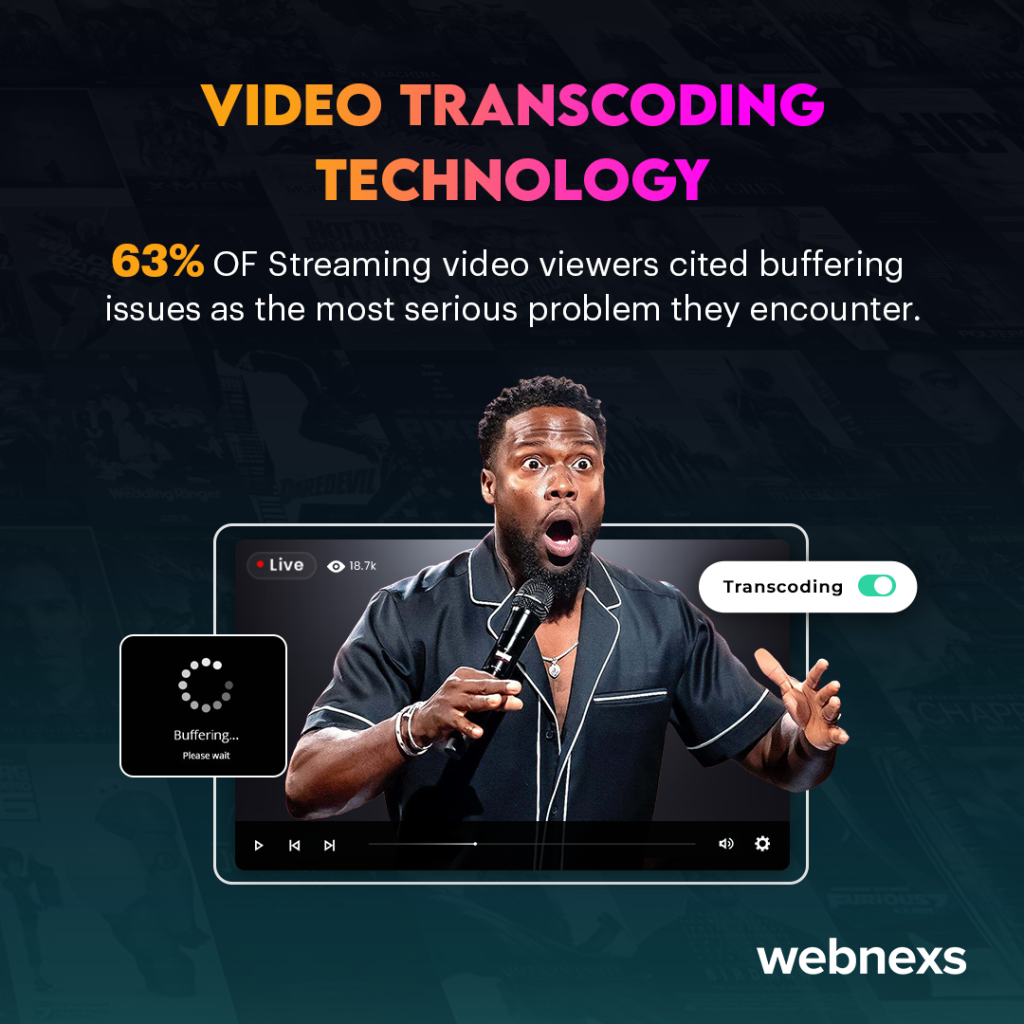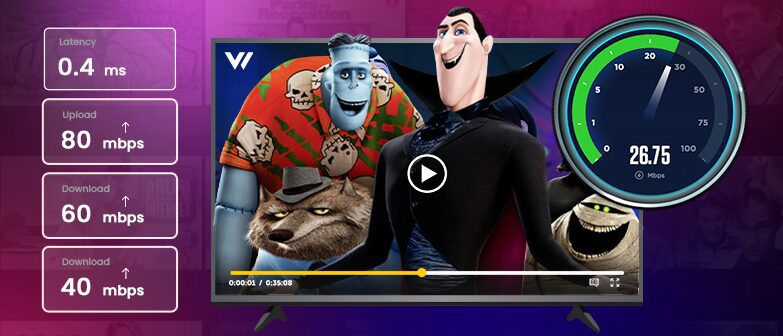Video streaming is a powerful technique for gathering together a mass audience. In recent years, digital video processing and communication technology have advanced tremendously. These advancements have made the idea of high-quality, real-time video streaming across several networks a reality. As video streaming grows more popular, one of the most commonly asked by new broadcasters is Bandwidth. How much video bandwidth do you require to stream video?
To stream video, You’ll need a suitable device and content providers. However, if you do not have a good internet connection, it will not work. You’ll have to deal with stuttering, delays, and screen freezes all the time. So knowing how much video bandwidth is needed to stream video is very important.
What is video bandwidth?
Video Bandwidth refers to the quantity of data or information that a transmission media, such as an internet connection, can transmit per unit of time in video streaming. It measures in bits per second (kbps), megabits per second (Mbps), or gigabits per second (GBPS) (Gbps).
Bandwidth refers to both your server’s ability to handle stress and traffic, as well as the amount of data you consumed.
High Bandwidth means you’ll be able to send more data, download and upload files faster, and stream HD content. Moreover, having more Bandwidth offers several benefits, such as allowing more simultaneous users to access your website, faster application performance, and the ability to support multiple parallel sessions.
Important Metrics related to Bandwidth
The amount of Bandwidth you can use is chosen by your plan & provider and how you access the Internet. In addition, the video bandwidth required varies depending on the activity. Therefore, specific metrics are necessary for understanding the importance of video bandwidth.

Bit Rate: The amount of data transmitted over a network at a particular time is the bit rate. The video quality and file size are related by bitrate. Higher bitrate streaming produces better quality streams but uses a lot of Bandwidth.
Frame Rate: The number of times consecutive images are shown in a video to create the illusion of motion. Streaming video at a faster frame rate is required for high-speed streaming, particularly in sports. The frame rate and video bandwidth are linked. The more frames per second you have, the more bandwidth you use.
Video Resolution: Video resolution refers to the width and height of a video in pixels. The video quality improves as the pixel count increases. Because high-resolution videos have big file sizes, they need more Bandwidth.
Compression – Uncompressed video files take up a lot of storage space. Converting large uncompressed video streams into smaller video files to reduce file size is known as video compression. As a result, compressed videos use less Bandwidth when they are transmitted.
Understanding Internet Speed: Upload and Download
There are two factors to consider when determining the speed of an Internet connection: download speed and upload speed. The rate at which data is transmitted between your network and the Internet is measured as upload and download speeds. That speed is calculated in megabits per second, just like Bandwidth (Mbps).
The download speed of your network is a measure of how quickly data from the Internet can enter it.
Upload speed is a measurement of how rapidly data can transmit from your computer or server to other computers or servers outside of your network. Kbps (kilobits per second) or Mbps (megabits per second) are commonly used to measure download and upload speeds.
Required Internet speed & Bandwidth for Video Streaming
For 480p video streaming, a minimum connection speed of 3 Mbps is suggested. Streaming services differ in terms of minimum download bandwidth. When several devices connect to the Internet simultaneously, a higher bandwidth may be required.
For streaming standard definition video without buffering or skips, such as live video to a Roku, Apple TV, Google TV, or Sony TV Blu-ray Disc Player, a broadband speed of 2 Mbit/s or more is suggested. Five megabits per second are indicated for High Definition content, whereas Ultra-High Definition content requires nine megabits per second.
Streaming Video
The amount of bandwidth needed to stream video is determined by the quality of the video. SD uses less Bandwidth than HD.
Based on the services and the video quality you’re streaming in, the amount of Bandwidth required can vary.
- Netflix download speeds are 3 Mbps in SD and 5 Mbps in HD.
- Hulu — download speeds of 3 Mbps for on-demand content and 8 Mbps for live TV are available.
- Amazon Prime – download speeds of 1 Mbps in SD and 5 Mbps in HD.
- 2.5 Mbps download from YouTube
- Download speed with HBO Max is 5 Mbps.
- Peacock provides a download speed of 2.5 megabits per second (Mbps).
- Download speed for Disney Plus is 5 Mbps.
- 2 Mbps download for ESPN Plus
- Download speeds of up to 5 Mbps are available through Sling.
Video Bandwidth For Streaming Recommendations
There are several requirements; the most important is the internet connection speed. It must be fast enough to stream the amount of data required to see the video at the set resolution.
The file’s length and resolution determine the minimal requirement. It’s also important to know how the file is encoded (also known as the file type).
The following is a list of the recommended minimum viewing speeds for each resolution:
• SD quality: 4.0 Megabits per second
• HD quality 6.0 Megabits per second (MPS)
• UHD (4K) quality requires a bitrate of 25 megabits per second.
In many industries, high-speed Internet is increasingly becoming a must. That’s why we’re all so excited about the future 5G network. When we talk about Internet speed, we mostly mean download speeds; most people want and expect quick downloads. This shows how we download movies and stream stuff. As a result, depending on your internet connection speed, you may be limited to some web tasks.
Read more: WHY DOES ADAPTIVE BITRATE (ABR) STREAMING MATTERS?
Below is an overview of what’s going on.
- 2-4 megabits per second: This is sufficient for leisurely Web browsing and email checking. A standard definition video can be streamed with this amount of data.
- 4-6 Mbps: Enough to search the web comfortably. Often fast enough to broadcast a 720p high-definition video, specific videos can be downloaded in under 20 minutes. 4 Mbps, on the other hand, can be slow.
- 6-10 Mbps: This is usually a good speed for accessing the web. Streaming a 1080p (high-definition) video is usually possible.
- 10-20 Mbps: For the “superuser” who desires to stream content and download files quickly.
- A connection with a speed of 20 Mbps or more can easily handle most tasks—people who need to run a large number of apps simultaneously, typically for business purposes. The network can be “blitzed” by users at these speeds.
Conclusion
Finally, it’s important to understand video bandwidth because it’s one of the most expensive aspects of live streaming setups. Subscribing to a data plan with appropriate Bandwidth ensures that you fulfil all of the speed requirements of the services you want to access. Consider investing in a reliable bandwidth service, and you’ll never be disappointed by technology
contact webnexs for more information on video bandwidth requirements for streaming video.


